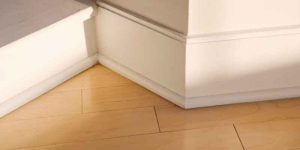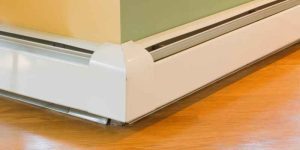Yes, MDF baseboards need to acclimate before installation to prevent warping or expansion issues. Acclimating MDF baseboards helps to stabilize their moisture content and minimize potential problems.
Acclimating MDF baseboards is a crucial step before installation. MDF, or medium-density fiberboard, is sensitive to moisture and temperature changes. By allowing the baseboards to acclimate in the installation environment, you can minimize the risk of warping, swelling, or other issues that may arise due to changes in moisture content.
Proper acclimation ensures that the baseboards are ready for installation and helps to maintain their structural integrity over time. Let’s explore the importance of acclimating MDF baseboards and the recommended acclimation period to ensure a successful and long-lasting installation.
Introduction To MDF Baseboards
MDF (medium-density fiberboard) baseboards are a popular choice for homeowners and builders due to their affordability and versatility. When installing MDF baseboards, it is important to consider whether they need to acclimate before being put in place.
What Is MDF?
MDF is an engineered wood product made from wood fibers combined with resin and wax, then compressed under high pressure to create a dense, smooth board. It is commonly used in construction and furniture due to its uniformity and lack of knots or grain.
Benefits Of MDF For Baseboards
MDF baseboards offer several advantages, including their smooth surface that is easy to paint, their resistance to warping and cracking, and their cost-effectiveness compared to solid wood options. Additionally, MDF baseboards can be shaped into various profiles and designs, providing flexibility for different aesthetic preferences.
The Acclimation Process
The acclimation process is an essential step when it comes to installing MDF baseboards. Acclimation is the process of allowing the material to adjust to the environment in which it will be installed. This helps to ensure that the baseboards will fit properly and prevent any issues with warping or shrinking. In this article, we will discuss why acclimation matters and the steps you need to follow for proper acclimation of wood products.
Why Acclimation Matters
Acclimation matters because it helps to prevent any issues that may arise from changes in temperature and humidity. Wood products, including MDF baseboards, are sensitive to changes in moisture content, which can cause them to expand or contract. This can lead to problems such as warping, buckling, and cracking. Acclimating the material allows it to adjust to the environment, reducing the risk of these issues occurring.
Acclimation Steps For Wood Products
When it comes to acclimating wood products like MDF baseboards, there are a few steps you need to follow:
- Store the baseboards in the room where they will be installed for at least 48 hours before installation. This will allow the material to adjust to the temperature and humidity of the space.
- Ensure that the room is at the temperature and humidity level that it will be during normal use. This will help prevent any changes in the material once it is installed.
- Remove the baseboards from their packaging and stack them horizontally with spacers between each board. This will allow air to circulate around the boards and help them to acclimate evenly.
- Check the moisture content of the baseboards using a moisture meter. The moisture content should be within 2% of the subfloor’s moisture content. If it is not, allow the baseboards to acclimate for longer.
- Install the baseboards once they have acclimated properly. Make sure to leave a small gap between the baseboards and the wall to allow for any expansion that may occur.
Following these steps will help to ensure that your MDF baseboards acclimate properly, reducing the risk of any issues with warping or shrinking. Proper acclimation is an important step in any installation project, and it should not be overlooked.

Do MDF Baseboards Require Acclimation?
MDF baseboards typically don’t require acclimation, unlike solid wood. They are less prone to warping or shrinking, making acclimation unnecessary. Once installed, MDF baseboards maintain their shape and size, providing a stable and durable option for your home’s interior design.
Comparing MDF And Natural Wood
MDF baseboards are less prone to warping compared to natural wood. They have a consistent density.
Expert Opinions On MDF Acclimation
Some experts recommend acclimating MDF baseboards to prevent potential issues post-installation.
Factors Influencing MDF Acclimation
Factors influencing MDF acclimation include temperature, humidity, and the environment where the baseboards will be installed. Proper acclimation ensures the stability and durability of MDF baseboards, reducing the risk of warping or shrinking over time.
Humidity And Temperature Effects
Humidity and temperature play a key role in acclimating MDF baseboards.
High humidity can cause MDF to swell, while low humidity may lead to shrinkage.
Storage And Handling Best Practices
Proper storage and handling are crucial for MDF acclimation.
Store MDF baseboards in a dry, well-ventilated area away from direct sunlight.

Preparing For Installation
It is recommended to acclimate MDF baseboards before installation. This is to ensure that the baseboards adjust to the temperature and humidity of the room, preventing any warping or damage in the future. It is best to let the baseboards sit in the room for at least 48 hours prior to installation.
Before installing MDF baseboards, it is essential to prepare the room and the baseboards themselves. Failure to do so can result in improper installation and unappealing results. In this section, we will discuss the necessary steps to take before installing MDF baseboards, including room preparation, measuring, and cutting the baseboards.
Room Preparation
The first step in preparing for installation is to ensure that the room is ready. This involves removing any furniture or obstructions and cleaning the walls and floor. Once the room is clear, it is essential to ensure that the walls are dry and free from any moisture. Moisture can cause the MDF baseboards to warp, so it is crucial to ensure that the room is adequately ventilated.
Measuring And Cutting MDF Baseboards
Measuring and cutting the MDF baseboards is the next critical step in preparing for installation. Accurate measurements are necessary to ensure that the baseboards fit correctly and look appealing. It is essential to measure the length of each wall and add an extra inch to accommodate any corners or angles.
Once the measurements have been taken, it is time to cut the MDF baseboards to size. A chop saw or a miter saw is the best tool for the job. It is essential to take care when cutting the baseboards to ensure that they are straight and of the correct length.
In conclusion, preparing for MDF baseboard installation involves room preparation, measuring, and cutting the baseboards. Taking the necessary steps to prepare will ensure that the installation is successful and that the baseboards look appealing.
Installation Tips For MDF Baseboards
When it comes to installing MDF baseboards, there are a few key tips to keep in mind to ensure a successful and long-lasting installation. From securing the MDF to the walls to sealing and adding finishing touches, each step plays a crucial role in achieving a professional-looking result.
Securing MDF To Walls
Securing MDF baseboards to the walls requires careful planning and the right tools. Here are some tips to help you with this step:
- Measure and cut the MDF baseboards to the desired length using a miter saw or a handsaw.
- Apply a construction adhesive to the back of the baseboard to ensure a strong bond with the wall.
- Place the baseboard against the wall, ensuring it is level and aligned with the floor. Use a level to check for accuracy.
- Secure the baseboard in place using finishing nails or a nail gun. Make sure to countersink the nails slightly below the surface of the MDF to create a seamless finish.
- Repeat the process for each section of the baseboard until the entire room is complete.
Sealing And Finishing Touches
After securing the MDF baseboards to the walls, it’s important to seal and add finishing touches to enhance their durability and appearance. Follow these tips:
- Fill any gaps or nail holes with wood filler and sand them smooth once dry.
- Apply a primer to the MDF baseboards to create a smooth and even surface for paint or stain.
- Choose your desired finish, whether it’s paint or stain, and apply it evenly using a brush or roller. Apply multiple coats if needed, allowing each coat to dry before applying the next.
- Once the paint or stain is dry, apply a clear topcoat or sealer to protect the MDF baseboards from moisture and wear.
By following these installation tips, you can achieve a professional and visually appealing result when installing MDF baseboards. Remember to measure accurately, secure the baseboards properly, and finish them off with the right products to ensure they stand the test of time.
Troubleshooting Common MDF Issues
When working with Medium Density Fiberboard (MDF) baseboards, it’s important to be aware of common issues that may arise. Troubleshooting these problems can help maintain the quality and longevity of your baseboards. Let’s explore some common MDF issues and how to address them.
Dealing With Expansion And Contraction
Expansion and contraction are common issues with MDF baseboards, especially when exposed to changes in temperature and humidity. To mitigate these effects, ensure that the MDF baseboards acclimate to the environment before installation. Additionally, sealing the edges and using proper fastening techniques can help minimize the impact of expansion and contraction.
Repairing Damaged MDF
Repairing damaged MDF requires attention to detail. For small dents or scratches, sand the damaged area and apply wood filler before sanding it smooth. Larger damages may require the replacement of the affected section. Proper priming and painting techniques can help restore the baseboards to their original condition.
Frequently Asked Questions
Do MDF Baseboards Require Acclimation Before Installation?
MDF baseboards do not need to acclimate before installation. Unlike solid wood, MDF (medium-density fiberboard) is less susceptible to moisture changes, making acclimation unnecessary.
How Long Should MDF Baseboards Acclimate?
Since MDF baseboards do not require acclimation, there is no specific time frame for them to acclimate. You can install them immediately after purchase without worrying about acclimation periods.
Are There Any Benefits To Acclimating MDF Baseboards?
Acclimating MDF baseboards does not provide any significant benefits. MDF is manufactured to be stable and less prone to expansion or contraction, eliminating the need for acclimation.
Can Acclimating MDF Baseboards Prevent Warping Or Swelling?
MDF baseboards are less likely to warp or swell compared to solid wood. Acclimation is not necessary as MDF’s composition makes it more resistant to moisture-related issues.
Conclusion
Incorporating acclimation for MDF baseboards is vital for a successful installation. Allowing the material to adjust to its environment minimizes warping and ensures a seamless fit. By following this simple step, you can enhance the longevity and appearance of your baseboards.
Prioritize acclimation for optimal results.


